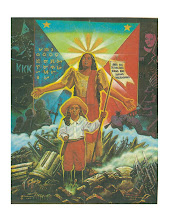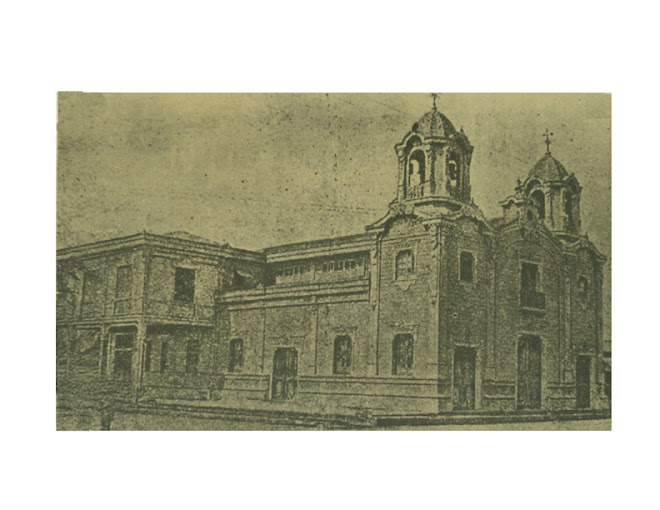It is not surprising for the IFI to have so many priests and even bishops who are at the same time also high-profile activists. The involvement of these IFI clerics in the cause-oriented movement is but a reflection of their church’s activist orientation, which is a product of its revolutionary heritage.
BY ALEXANDER MARTIN REMOLLINO
Bulatlat
During this year’s June 12 rally commemorating Independence Day, Bp. Alberto Ramento – the ninth supreme bishop of the Iglesia Filipina Independiente (IFI or Philippine Independent Church) – expressed some pride at being the chairman of his church’s Council of Bishops. In so being, he said, he was the chairman of what he described as a group of “revolutionary bishops.”
An independent fact-finding team led by lawyer Rex Fernandez found that the DVD players and mobile phone supposed to have been taken by the killers from Ramento were actually stolen on two separate incidents before the killing. The killing, the fact-finding team found, took place when there was nothing more to be stolen from the dilapidated rectory where Ramento stayed.
As early as mid-2005, Ramento had said of having received information from his military contacts that he was on the Order of Battle, together with four IFI priests: Fr. Mario Quince, parish priest of Paniqui, Tarlac; Fr. Gregorio Lacanaria, parish priest of Victoria, Tarlac; Fr. Marshal Bautista, parish priest of Pura, Tarlac; and Fr. William Tadena, parish priest of La Paz, Tarlac. Tadena had been shot to death on March 13 that same year.
That same year also, an IFI priest – Fr. Allan Caparro of the Diocese of Samar – was ambushed together with his wife Ailyn. Both fortunately survived.
In Gingging’s case, Chief Supt. Antonio Nanas, Caraga regional police director, immediately issued a statement saying “personal grudge” was behind the killing.
Two days before Gingging’s death, Fr. Antonio Ablon of Cagayan de Oro City – also belonging to the IFI – had received a threat on his cellular phone. “Fr. Ablon, patay gani ang supreme bishop ikaw pa kaha i sample ka namo dinhi sa CDO” (Fr. Ablon, even the supreme bishop was killed, all the more can you be made an example here in Cagayan de Oro City), read the message which was reportedly sent from the number 09203546270.
Activist clerics, revolutionary origins
Ablon, Quince, Lacanaria, Bautista, and Caparro are all known as activists and human rights advocates – as were Gingging, Ramento, and Tadena.
Ramento, in particular, was at the time of his death the co-chairman of the Ecumenical Bishops Forum (EBF) together with Roman Catholic Bishop Deogracias Iñiguez of Caloocan City and a convener of the Movement of Concerned Citizens for Civil Liberties (MCCCL). He and Tadena were staunch supporters of the Hacienda Luisita farm and mill workers, who staged a historic strike in 2004 demanding land distribution, higher wages and more benefits.
It is not surprising for the IFI to have so many priests and even bishops who are at the same time also high-profile activists. The involvement of these IFI clerics in the cause-oriented movement is but a reflection of their church’s activist orientation.
The IFI’s activist orientation is clear in the value that it places on liberty. “Liberty is one of the most precious gifts with which the Creator has favored us; therefore we may in no way set more limits to it than those, which the purest morality and right conscience impose on all things,” reads part of the1903 Doctrine and Constitutional Rules of the Iglesia Filipina Independiente.
The said document goes on to state that:
Our morality consists of loving the good for its own sake, and in saying this, we mean specifically that we ought to love, practice, and defend philanthropy, justice, honor, liberty, labor, and the sciences.
Philanthropy and justice are the distinctive characteristics, if it is true that we differ in some way from the other animals, which elevate our moral level with theirs.
Labor products us what we need and is the untouchable front of well-being. We must therefore love it and seek it always.
Honor dignifies and ennobles us.
The sciences provide our minds with necessary knowledge, and are the most valuable factors for our progress in all their branches.
Liberty and the noble ambitions, which it arouses, are the indispensable elements and the potent means for our exaltation for progress, for science, for civilization, and, in short, for our general perfection.
The IFI’s activist orientation as expressed in this concept of good is a product of the church’s revolutionary origins.
Historian Teodoro A. Agoncillo described the IFI as “the only living and tangible result of the (1896) Revolution.” And rightly so, for it was founded by people who were key players in the ferment of 1896 – a revolutionary armed struggle against Spanish colonialism.
Religion and resistance
With religion historically having taken deep root in the Filipino consciousness, it is not at all a wonder that nationalism in the Philippines has at times taken religious aspects.
In the early revolts, which were all localized struggles, the rejection of the Spanish-imposed Roman Catholic religion often took the form of a return to pre-colonial religious beliefs and practices. As Roman Catholicism sank deeper and deeper into the popular psyche, rebels began blending some Roman Catholic doctrines and rites with their old religious beliefs and practices. The combination contained more and more Roman Catholicism and eventually, the religious aspect of resistance took on the demand for equal rights for Filipinos within the Roman Catholic Church.
In the controversy between regular and secular priests, lay Filipinos generally sympathized with the latter because native priests were seculars. The campaign for the Filipinization of the clergy became an important part of the nationalist agitation which resulted in the 1896 Revolution. Filipinization called for an end to the monopoly of Spanish priests in the Roman Catholic Church and granting their Filipino counterparts the same rights and positions they enjoyed.
Many native priests thus sympathized with the Revolution, even as they had to resolve the conflict between their patriotic sentiments and their allegiance to the Roman Catholic Church which opposed the Filipino people’s anti-colonial struggle.
Gregorio Aglipay
One of the priests was Fr. Gregorio Aglipay. Born in Batac, Ilocos Norte, he was orphaned at an early age and grew up as an agricultural worker in the tobacco fields. He had deep grievances against Spanish colonialism, having been arrested at 14 for not meeting his tobacco quota.
He had been a priest for only six years when the Revolution broke out. He would be the only priest to attend the Malolos Congress.
When the U.S. intervened in the war with Spain, Aglipay accepted from Abp. Bernardino Nozaleda the mission of trying to win over the Filipino revolutionary leaders to the side of Spain and against the American forces. Failing to convince them, he decided to join them and Gen. Emilio Aguinaldo, president of the Revolutionary Government, appointed him as military vicar general on Oct. 20, 1898.
Before that, cabinet president Apolinario Mabini had prevailed upon the Revolutionary Government to declare civil marriages valid, based on the doctrine of separation of church and state.
Also at Mabini’s instance, the Revolutionary Government served notice that it no longer recognized Nozaleda’s authority. It even instructed Filipino priests not to occupy vacant parishes nor perform religious services without its approval.
Aglipay followed this up with a letter urging Filipino priests to rally to the side of the Revolution and create a council that would work for the Filipinization of the Roman Catholic Church in the Philippines while retaining its loyalty to the Vatican.
Aglipay found himself being excommunicated by Nozaleda in May 1899 though he had not expressed schismatic intentions. In a subsequent manifesto, Mabini supported Aglipay and urged Filipino priests to elect an Ecclesiastical Council to set up a provisional organization for the Filipino National Church – one which, though still loyal to the Vatican, would work in harmony with the Revolutionary Government.
On Oct. 23 that year, Aglipay called an Ecclesiastical Assembly in Paniqui, Tarlac. The body adopted a temporary constitution for a Filipino Catholic Church and that the body would not recognize any foreign bishop unless he had the approval of a majority of the Filipino priests – a position the Spanish hierarchy refused to give in to.
The Roman Catholic Church authorities’ inflexibility and the pro-friar leanings of the first American Apostolic Delegate, Msgr. Placido Chapelle, gained more supporters for the idea of a Filipino church independent of the Vatican. But soon after the Paniqui Assembly, Filipino-American hostilities intensified and Aglipay left for the Ilocos to fight as a guerrilla general. He surrendered in May 1901.
Birth of the IFI
In August 1902, the revolutionary scholar and journalist Isabelo “Don Belong” de los Reyes – who a year before had founded the country’s first labor union, the Union Obrera Democratica (UOD or Democratic Labor Union) – proposed to his membership the establishment of the IFI with Aglipay as supreme bishop. Aglipay headed the new church a month later.
De los Reyes was arrested the next year after a series of strikes by the UOD. He was, however, pardoned by Gov. Gen. William Howard Taft and released after a few weeks in detention. Shortly after, he retired from unionism and ran for public office.
Aglipay ran for president in the 1935 Commonwealth election, but lost to Manuel L. Quezon. He died shortly after.
Continuing activism
But the legacies of De los Reyes and Aglipay have not been lost to succeeding generations of the IFI faithful.
Through the years, the IFI has been able to maintain its ties with its revolutionary origins. It remains a pillar of church activism in the Philippines, and was described in a recent Philippine Daily Inquirer editorial as “perhaps the most political of all the Christian churches, given to political activism and organizing and often taking strong positions against the establishment.”
The IFI is a founding member of the National Council of Churches in the Philippines (NCCP), a conciliar body of various churches advocating what it describes as a society that is “just, egalitarian, self-reliant and sustainable.”
The IFI is perhaps the largest among the NCCP member churches, with various estimates placing its membership at two to three million scattered in 35 dioceses throughout the country.
Enjoying Concordat relations with the Old Catholic Church and the Anglican provinces, it is described as “the largest church alternative to the Roman Catholic Church in the Philippines” in a recent statement by Jose Maria Sison, chairperson of the International League of Peoples’ Struggle (ILPS) and a former professor of literature and the social sciences. Bulatlat
References:
1. Doctrine and Constitutional Rules of the Iglesia Filipina Independiente, 1903.
2. Fr. Apolonio Ranche, “An Introduction to the Iglesia Filipina Independiente (Philippine Independent Church),” 1999.
3. Official website, Iglesia Filipina Independiente (http://www.ifi.ph/).
4. Renato Constantino, The Philippines: A Past Revisited, Manila: 1975.
5. Teodoro A. Agoncillo, History of the Filipino People (8th Edition), Quezon City: Garotech Publishing, 1990.
6. “Death of a Bishop,” Editorial, Philippine Daily Inquirer, Oct. 10, 2006.
7. Jose Maria Sison, “Tribute to Bishop Alberto Ramento: The Bishop of the Workers and Peasants,” Oct. 6, 2006.
Tuesday, May 5, 2009
Subscribe to:
Post Comments (Atom)





No comments:
Post a Comment